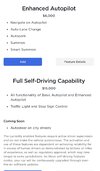That’s far too much explaining.
But Tesla calls it FSD and Full Self Driving on their website.
FSD Chip
Build AI inference chips to run our
Full Self-Driving software, considering every small architectural and micro-architectural improvement while squeezing maximum silicon performance-per-watt. Perform floor-planning, timing and power analyses on the design. Write robust tests and scoreboards to verify functionality and performance. Implement drivers to program and communicate with the chip, focusing on performance optimization and redundancy. Finally, validate the silicon chip and bring it to mass production in our vehicles.”
And the chip is used in this feature you can buy
View attachment 894638





